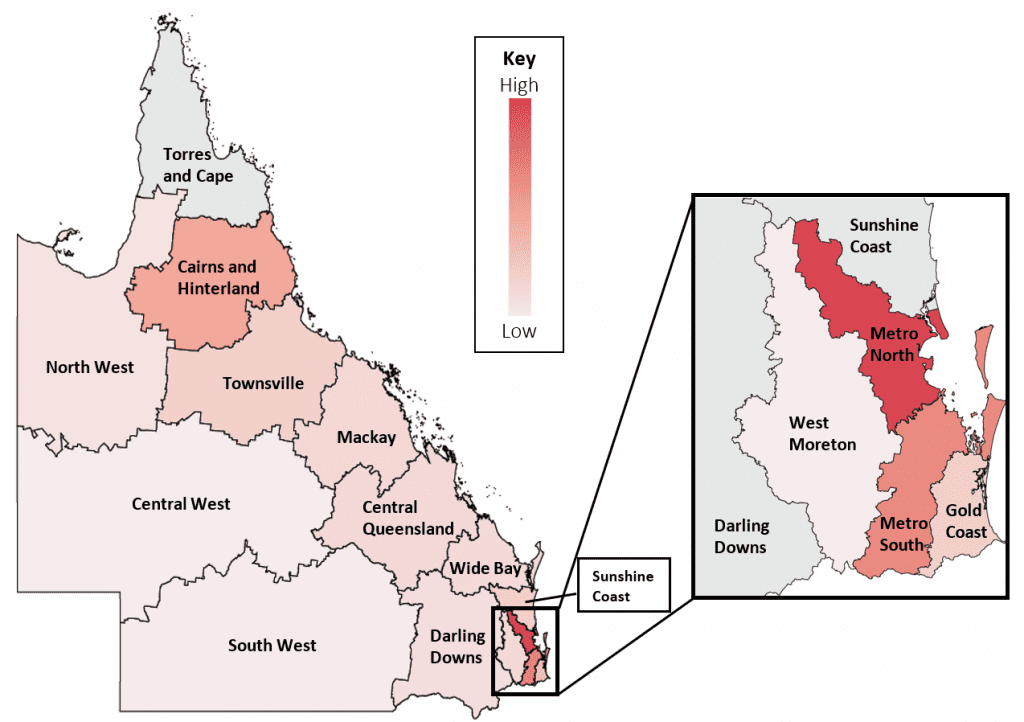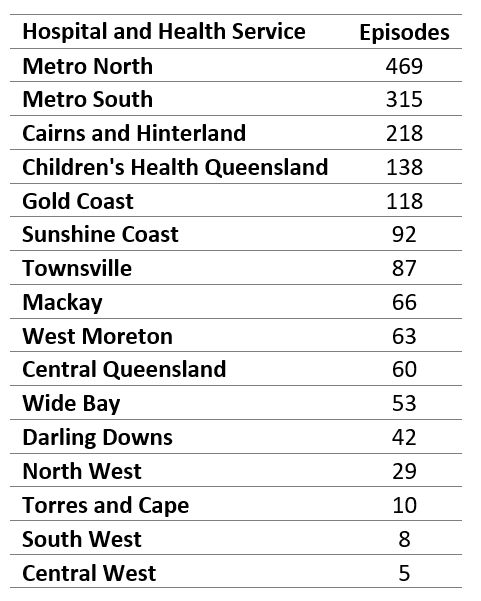Caustic injury-related hospitalisations in Queensland public acute hospitals: 01 Jan 2018 to 31 Dec 2023
Background
This report presents patterns and trends in caustic injury related hospitalisations in Queensland public acute hospitals over a six-year time-period from Jan 2018 to Dec 2023 covering the pre-pandemic (2018-2019), pandemic (2020) and post-pandemic (2021-23) years as part of an expanded surveillance and monitoring activity.
Key findings
Between 01 Jan 2018 to 31 Dec 2023 (6 years):
- 1,773 caustic injury-related hospitalisations occurred in Queensland public acute hospitals.
- This equated to 3,728 days of inpatient care.
- 58% of cases were males.
- 0 – 4 years olds accounted for 15% of all caustic injury cases and 15% of inpatient days.
- X49 Accidental poisoning by and exposure to other and unspecified chemicals and noxious substances was the most frequent external cause code (69%).
Key figures
Observed trends over time for caustic injury-related hospitalisations
Age and sex breakdown for caustic injury-related hospitalisations
| Number of caustic injury-related hospitalisation episodes and associated patient bed days by age group and year | ||||||||||||
|---|---|---|---|---|---|---|---|---|---|---|---|---|
|
Age Group |
2018 |
2019 |
2020 |
2021 |
2022 |
2023 |
||||||
|
Episodes |
Patient Days |
Episodes |
Patient Days |
Episodes |
Patient Days |
Episodes |
Patient Days |
Episodes |
Patient Days |
Episodes |
Patient Days |
|
|
00 – 04 |
59 |
169 |
21 |
85 |
55 |
80 |
46 |
100 |
38 |
47 |
45 |
68 |
|
05 – 09 |
NP^ |
NP |
7 |
11 |
5 |
6 |
7 |
7 |
NP |
8 |
6 |
7 |
|
10 – 14 |
11 |
24 |
9 |
26 |
15 |
36 |
20 |
22 |
8 |
10 |
12 |
14 |
|
15 – 19 |
25 |
37 |
17 |
29 |
30 |
34 |
45 |
66 |
20 |
25 |
21 |
28 |
|
20 – 24 |
35 |
70 |
16 |
20 |
36 |
49 |
34 |
75 |
31 |
72 |
35 |
71 |
|
25 – 29 |
24 |
40 |
25 |
47 |
39 |
62 |
31 |
35 |
30 |
34 |
28 |
74 |
|
30 – 34 |
18 |
42 |
15 |
41 |
19 |
22 |
21 |
37 |
28 |
54 |
31 |
51 |
|
35 – 39 |
12 |
16 |
28 |
39 |
20 |
54 |
27 |
102 |
20 |
44 |
24 |
42 |
|
40 – 44 |
21 |
39 |
18 |
20 |
22 |
35 |
12 |
14 |
14 |
34 |
22 |
23 |
|
45 – 49 |
16 |
32 |
20 |
114 |
15 |
34 |
29 |
48 |
20 |
62 |
21 |
51 |
|
50 – 54 |
14 |
17 |
19 |
29 |
15 |
57 |
17 |
51 |
11 |
77 |
15 |
45 |
|
55 – 59 |
13 |
34 |
8 |
22 |
17 |
43 |
9 |
12 |
14 |
15 |
11 |
23 |
|
60 – 64 |
7 |
15 |
8 |
14 |
6 |
6 |
16 |
38 |
10 |
58 |
12 |
75 |
|
65 – 69 |
NP |
NP |
10 |
28 |
10 |
14 |
15 |
66 |
10 |
37 |
8 |
10 |
|
70 – 79 |
8 |
16 |
7 |
10 |
10 |
22 |
15 |
41 |
13 |
37 |
19 |
66 |
|
80+ |
NP |
NP |
5 |
27 |
NP |
NP |
9 |
13 |
9 |
15 |
9 |
44 |
^Not publishable due to the low number of cases.
|
Top 10 principal diagnoses for caustic injury-related hospitalisations |
|||
|---|---|---|---|
|
Principal Diagnosis |
Episodes |
Patient Days |
|
|
T549 |
Toxic effect of corrosive substance, unspecified |
282 |
481 |
|
T261 |
Burn of cornea and conjunctival sac |
212 |
357 |
|
T543 |
Toxic effect of corrosive alkalis and alkali-like substances |
114 |
253 |
|
T264 |
Burn of eye and adnexa, part unspecified |
111 |
117 |
|
T55 |
Toxic effect of soaps and detergents |
108 |
129 |
|
T280 |
Burn of mouth and pharynx |
54 |
110 |
|
T253 |
Burn of third degree of ankle and foot |
52 |
222 |
|
T281 |
Burn of oesophagus |
47 |
388 |
|
T243 |
Burn of third degree of hip and lower limb, except ankle and foot |
43 |
217 |
|
T242 |
Burn of second degree of hip and lower limb, except ankle and foot |
43 |
127 |
|
Body region and nature of injury for caustic injury-related hospitalisations |
||||
|---|---|---|---|---|
|
Body Region |
Burn or Corrosion |
Overdoses, Poisoning or Toxic Effects |
Wounds and Superficial Injuries |
Multiple, Other and Unspecified Injuries |
|
Head and Neck |
573 |
0 |
86 |
93 |
|
Trunk |
62 |
0 |
18 |
6 |
|
Upper limb |
146 |
0 |
73 |
NP^ |
|
Lower limb |
178 |
0 |
16 |
0 |
|
Systemic |
0 |
507 |
0 |
0 |
|
Multiple body regions |
NP^ |
0 |
0 |
0 |
|
Unspecified body region |
7 |
0 |
0 |
0 |
^Not publishable due to the low number of cases.
Note: body regions and nature of injury was assigned using J-MAX
|
Number of caustic injury-related hospitalisations by hospital and Health Service of facility providing acute care |


Please refer to Hospital and Health Services by recognised public hospitals and primary health centres for a map of specific hospitals and health services facilities.
|
Mode of separation for caustic injury-related hospitalisations |
||
|
Mode of Separation |
Episodes |
Patient Days |
|
Home/usual residence |
1,433 |
2,892 |
|
Transfer to another hospital |
162 |
302 |
|
Correctional facility |
61 |
154 |
|
Episode change |
59 |
263 |
|
Discharged at own risk |
39 |
53 |
|
Died in hospital |
5 |
21 |
|
Other |
14 |
43 |
About us
The Jamieson Trauma Institute (JTI) connects clinicians, researchers, government and industry partners striving to advance trauma prevention, research and clinical management, to deliver the best possible care for people who experience traumatic injury. JTI is funded via a partnership between the Motor Accident Insurance Commission, Metro North Health and Queensland University of Technology.
General enquiries: Jamieson_trauma_institute@health.qld.gov.au
Data scope and definitions
This overview was produced by the Jamieson Trauma Institute, in consultation with the Queensland Injury Surveillance Unit and the Statistical Services Branch, Queensland Health using Queensland Hospital Admitted Patient Data Collection (QHAPDC) (derived subset of data tables comprising injury related hospital admissions from all Queensland public acute hospitals excluding Mater South Brisbane Hospitals).
Data Scope
- Includes episodes of admitted patient care with separation date between 01 Jan 2018 & 31 Dec 2023.
- Caustic injury-related hospitalisation is defined by selected ICD-10-AM principal diagnosis related to “caustic injury” with external cause codes X49, X69 and X83.
- Care Type = Acute.
- This overview presents raw counts, not age standardised rates, as data relate to episodes of care and not individual patients.
Report prepared by:
|
Shahera Banu Data Analyst |
Genevieve Westacott Health Information Manager |
